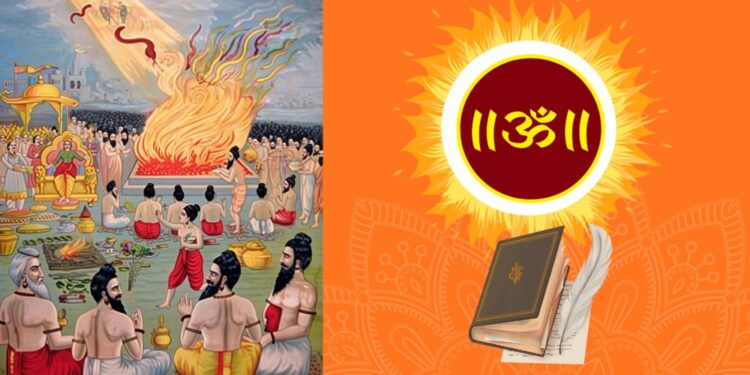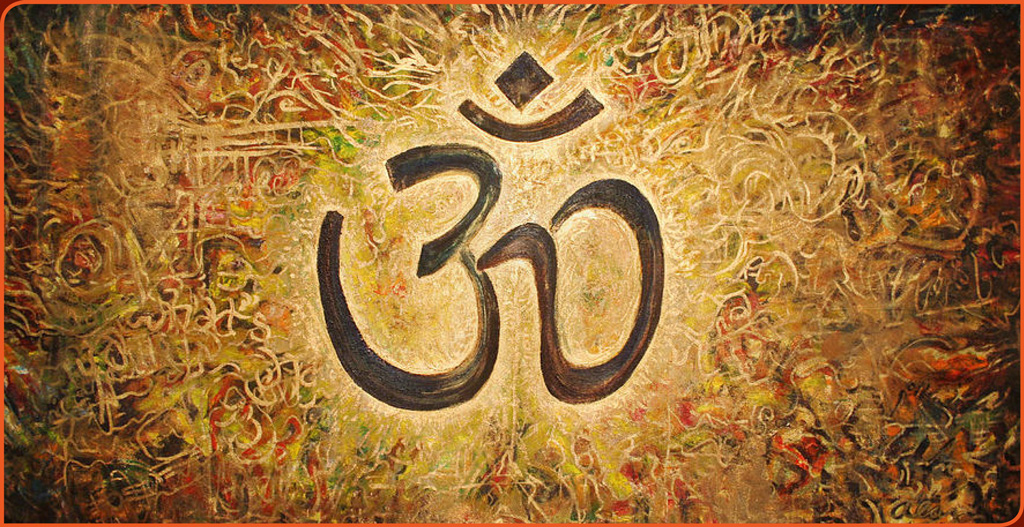The word Upaniṣad (उपनिषद्) is not the name of the book. Upaniṣad (उपनिषद्) primarily means knowledge, Vidyā (विद्या). In one word, Upaniṣad (उपनिषद्) means Brahmavidyā (ब्रह्मविद्या). It is like any other Saṃskṛta (संस्कृत) word. Upaniṣad (उपनिषद्) has two prefixes, Upa (उप) and Ni (नि), added to the word Ṣad (षद्) with the root Ṣadḷ (षद्ऌ). The prefix Upa (उप) means that which is the nearest. The nearest is oneself, “I,” the Ātmā (आत्मा). The prefix Ni (नि) means certainty, that which is well ascertained. Therefore, Ni (नि) implies knowledge. The root Ṣadḷ (षद्ऌ) has threefold meanings – षद्ऌ विशरणगत्यवसादनेषु: 1) Viśaraṇam (विशरणम्) or Śithilīkaraṇam (शिथिलीकरणम्) means to loosen; 2) Avasādanam (अवसादनम्) means to destroy; and 3) Gati (गति) or Gamanam (गमनम्) means to take to, or to lead to. The word Ṣad (षद्), being the agent of action indicated by its root and, hence, with the implied meanings of prefixes Upa (उप) and Ni (नि), means that which loosens, puts an end to, and makes one reach.
What does it loosen? Upaniṣad (उपनिषद्) loosens the bondage of Saṃsāra (संसार). It loosens the Āsakti (आसक्ति), excessive attachment, to sense objects. It loosens wrong values, wrong attitudes, or improper insistences. What does it destroy? It destroys ignorance. It destroys self-ignorance. It destroys ignorance about the truth. Where does it take? It takes one to Brahman (ब्रह्मन्). Therefore, Upaniṣad (उपनिषद्) means the knowledge that loosens the bondage of Saṃsāra (संसार), the knowledge that destroys self-ignorance, and the knowledge that takes one to Brahman (ब्रह्मन्), to one’s true nature, one’s Svarūp (स्वरूप). सर्व दुःख निवृत्ति द्वारा मोक्ष प्राप्यति इति उपनिषद्, sarva duḥkha nivṛtti dvārā mokṣa prāpyati iti upaniṣad. It eliminates all kinds of sorrows or Duḥkha (दुःख) and takes one to Mokṣa (मोक्ष). That is called Upaniṣad (उपनिषद्). It is the Vidyā (विद्या) or knowledge revealed by a body of words or a set of Mantrāḥ (मन्त्राः). In a secondary sense, the body of the words that reveal this knowledge is also called Upaniṣad (उपनिषद्). When we refer to a book, “This is Upaniṣad (उपनिषद्),” the word Upaniṣad (उपनिषद्) is used in the secondary sense. The primary meaning of the word Upaniṣad (उपनिषद्) is knowledge, the knowledge that destroys self-ignorance and takes one to Brahman (ब्रह्मन्). In other words, Brahmavidyā (ब्रह्मविद्या), or self-knowledge, is called Upaniṣad (उपनिषद्). Such a body of words or the set of Mantrāḥ (मन्त्राः) revealing the self-knowledge, revealing the identity between the individual and the totality (the entirety), appear in various sections of different Vedāḥ (वेदाः). For instance the set of Mantrāḥ (मन्त्राः) in the Atharvaveda (अथर्ववेद), in Muṇḍakaśākhā (मुण्डकशाखा), in Mantravibhāga (मन्त्रविभाग) is known as Muṇḍakopaniṣad (मुण्डकोपनिषद्). Generally, the name given to a Upaniṣad (उपनिषद्) does not have much significance or implication. Ṛṣayaḥ (ऋषयः) never bothered to give names. Sometimes it isn’t easy to even know who the Guru (गुरु) is or who the Śiṣya (शिष्य) is. What is passed on by Paraṃparā (परंपरा), by tradition, is knowledge, and some name is given to the set of Mantrāḥ (मन्त्राः). While some names are based on content, or main topics they deal with, or the Ṛṣi(ऋषि) who compiled it, or the Ṛṣi(ऋषि) to whom it may be attributed, or the way they are structured, it is also seen that some names are given based on the first word of the first verse of the set of Mantrāḥ (मन्त्राः). For instance, Īśāvāsyopaniṣad (ईशावास्योपनिषद्) begins with ईशावास्यमिदं सर्वं īśāvāsyamidaṃ sarvaṃ, all this is pervaded by Īśvara (ईश्वर). The first word of the first verse is Īśāvāsya (ईशावास्य), and so the Upaniṣad (उपनिषद्) is given the name Īśāvāsyopaniṣad (ईशावास्योपनिषद्). Similarly, Kenopaniṣad (केनोपनिषद्) of the Sāmaveda (सामवेद) begins with केनेषितं पतति प्रेषितं मनः keneṣitaṃ patati preṣitaṃ manaḥ, by whom willed and directed does the mind light on its subjects? The first word of the verse is Kena (केन), and so the Upaniṣad (उपनिषद्) is given the name Kenopaniṣad (केनोपनिषद्).
In the case of Muṇḍakopaniṣad (मुण्डकोपनिषद्), although the Muṇḍaka (मुण्डक) name is derived from the Muṇḍakaśākhā (मुण्डकशाखा) of the Atharvaveda (अथर्ववेद), there is a mention in the religious votive rites of Vrataṃ (व्रतं) of how the name Muṇḍaka (मुण्डक) originated. Why is it called Muṇḍakopaniṣad (मुण्डकोपनिषद्)? It is said that when someone wants to study this Muṇḍakaśākhā (मुण्डकशाखा), they have to adhere to some Vrataṃ (व्रतं), some vows, and some discipline. One of the disciplines is Śirovrataṃ (शिरोव्रतं), where one keeps a fire in a pot on one’s head while studying. It is symbolic. Fire is a symbol of knowledge. In those Vedāntika (वेदान्तिक) times, there were primarily two sources of light: the sun and fire. A very well-lit fire and the blazing sun have almost the same color, a reddish-orange or ochre hue. That particular color becomes a symbol of light, and light is a symbol of knowledge. Ignorance is symbolized by darkness. Knowledge is symbolized by light. In Hindu tradition, prayers are initiated by lighting a lamp. Generally, Pūjā (पूजा) or a worship ritual is concluded with Ārtī (आरती), implying that there is a prayer for knowledge, a prayer for the right kind of wisdom. There is always a proper way of looking at the world. There is a proper way of evaluating oneself and the situation. So, lighting a lamp is a prayer seeking proper knowledge and wisdom. “I must look at my life situation, myself, and Īśvara (ईश्वर) properly.” Seeing Īśvara (ईश्वर) properly means knowing Īśvara (ईश्वर) “as He is.”
One who commits their lifestyle exclusively to the pursuit of self-knowledge and discovering the truth is given certain clothes of ochre color – the color of light or the color of fire. One who wears these clothes implies and declares to society that he is the one who has committed to the pursuit of knowledge, with the exclusion of all other pursuits. Such a person is called a Saṃnyāsī (संन्यासी). Total commitment to the pursuit of knowledge at the exclusion of everything else is called Mumukṣutvam (मुमुक्षुत्वम्). The person with such commitment is called a Mumukṣu (मुमुक्षु), one who is desirous of Mokṣa (मोक्ष), one who wants Mokṣa (मोक्ष). What type of Mumukṣutvam (मुमुक्षुत्वम्) should one have? They say it should be Dīptaśikhāvat (दीप्तशिखावत्). A traditional example is a person adorning a huge matted hair lock, a Jaṭā (जटा). The hair of the Jaṭā (जटा) is usually dry because of the lack of oil. Somehow, a spark of fire comes and hits him on the head. At that moment, he may be eating his favorite dish, listening to something he likes, or doing something he needs to do. The Jaṭā (जटा) begins to burn. Instantly, he gives up everything and wants only one thing: water to extinguish the fire. Nothing else matters. He needs water from wherever it is available, from whoever can supply it, or in whatever condition it is. Everything is subservient. He must have water to extinguish the flame. That kind of single-pointed commitment to adhere to the desire for Mokṣa (मोक्ष) is called Mumukṣutvam (मुमुक्षुत्वम्). Such commitment is symbolized by Śirovrataṃ (शिरोव्रतं), holding fire on one’s head, implying that here is a person who has committed to Mokṣa (मोक्ष) at the exclusion of all other life pursuits.
There is another meaning of “fire on the head.” Since fire symbolizes knowledge, here is a person who has some knowledge. Which knowledge? Knowledge can mean anything. Here, knowledge means maturity. One who practices Śirovrataṃ (शिरोव्रतं) is relatively mature. He is psychologically grown up, not just physically. What does maturity mean? Who is mature? A mature person is a more objective person who objectively evaluates life experiences, relationships, and himself. A relatively objective person is a factual person. On the other hand, a relatively subjective person lives in his subjective world, in his world of likes and dislikes. He tries to fix relationships in his life situations based on his likes and dislikes. He tries to fix up the external world in the structure laid down by his likes and dislikes. There is an absence of Vairāgya (वैराग्य), an absence of dispassion in such a person. A mature person is Viraktaḥ (विरक्तः), one who has Vairāgya (वैराग्य), one who has dispassion. What does it mean to be dispassionate?
One is said to be dispassionate when one is objective. To be dispassionate, one need not give up things. Even if one has the opportunity to give up, and one does, with whatever world one has to relate to, one must be objective. Vairāgya (वैराग्य) does not mean that formerly, one had countless likes and dislikes but has now reduced to a few. Vairāgya (वैराग्य) means “I learn to be objective in every life situation. Whatever life situations I face, little or less, I still learn to be objective.” A person practicing Śirovrataṃ (शिरोव्रतं) who knows means a person who lives objectively and possesses both Vairāgya (वैराग्य) and Mumukṣutvam (मुमुक्षुत्वम्). Such conduct must be observed at all times. Mumukṣutvam (मुमुक्षुत्वम्) implies exclusive commitment. During meditation, as पूज्य स्वामी दयानन्द सरस्वतीजी, pūjya svāmī dayānanda sarasvatījī would say, “I have an appointment with myself,” implying that this is my most important and valuable time. “It is I with whom I am giving time. I should give exclusive and complete attention to the pursuit of study.” A Mumukṣu (मुमुक्षु) or Saṃnyāsī (संन्यासी) is committed to giving 24/7 attention. Only such a person can study Upaniṣad (उपनिषद्). Another popular meaning of Muṇḍakopaniṣad (मुण्डकोपनिषद्) stems from the word Muṇḍanaṃ (मुण्डनं). Muṇḍanaṃ (मुण्डनं) means shaving of the head. Muṇḍakopaniṣad (मुण्डकोपनिषद्) is so named because one who studies this Upaniṣad (उपनिषद्) has shaved his head. What is the significance of shaving the head? Just as innumerable hairs are on the head, so are there countless desires in individuals. There is a similarity between hair and desires. Hair on one’s head symbolically represents desires. The more one cuts hair, the more it grows. Likewise, the more desires are fulfilled, the more new ones emerge. Fulfilling a given desire does not guarantee that it will not reappear. Shaving or removing hair means suspending all desires. Though one can suspend desires, they don’t go away for good. They will be there as long as the mind is. One has to be objective with a resolve that “मनोबुद्ध्यहङ्कार चित्तानि नाहं, manobuddhyahaṅkāra cittāni nāhaṃ, neither am I the mind nor the intellect nor the subconscious mind or ego.” That is the true relinquishing of desires. That is the shedding of all binding desires. So, a Mumukṣu (मुमुक्षु) with a shaven head means a person who has suspended all desires. He has only one desire – Mokṣecchā (मोक्षेच्छा), a desire for liberation. He commits to the lifestyle in the exclusive pursuit of knowledge. That is why it is called Muṇḍakopaniṣad (मुण्डकोपनिषद्).




![[ India Today ] Ohio senator JD Vance thanks wife, a Hindu, for helping him find Christian faith](https://hinduvishwa.org/wp-content/uploads/2024/06/us-senator-jd-vance-reveals-how-his-hindu-wife-usha-helped-him-find-his-christian-faith-image-re-272530504-16x9_0-120x86.webp)










